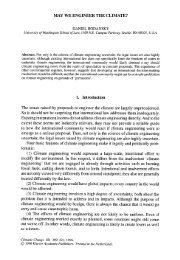ThorEA - Towards an Alternative Nuclear Future.pdf
ThorEA - Towards an Alternative Nuclear Future.pdf
ThorEA - Towards an Alternative Nuclear Future.pdf
You also want an ePaper? Increase the reach of your titles
YUMPU automatically turns print PDFs into web optimized ePapers that Google loves.
Frequently Asked Questions continued<br />
Q8. <strong>ThorEA</strong> has suggested <strong>an</strong> ADSR core with a criticality factor of 0.985, but that optimal ADSR core design calculations<br />
may favour higher core criticalities <strong>an</strong>d hence lower beam currents, relaxing somewhat the design parameters of the<br />
proton accelerator. Why not go to higher criticality factors, <strong>an</strong>d perhaps greatly simplify the accelerator design?<br />
A8. <strong>ThorEA</strong>’s initial choice of criticality coefficient is based upon how far below k=1 it is feasible to go yet still be able exploit<br />
currently realisable accelerator technologies. A total proton beam power of 10MW is close to the current state of the art<br />
<strong>an</strong>d therefore is <strong>an</strong> entirely appropriate starting point to maximise the flexibility in the criticality whilst increasing safety<br />
margins. It should also be noted that the report indicates that it may be desirable to deliver the total driver power using<br />
several accelerators simult<strong>an</strong>eously. This will also facilitate a simplification of the design of each individual accelerator,<br />
albeit at the expense of complexity in beam delivery. This latter point has already been addressed by IPR lodged by STFC<br />
<strong>an</strong>d members of <strong>ThorEA</strong>.<br />
Q9. <strong>ThorEA</strong> suggests higher currents are, broadly speaking, easier to achieve th<strong>an</strong> higher energies. Doesn’t this conflict<br />
with the opinion of the ESS, which is updating its parameters from the 2003 design to decrease the current <strong>an</strong>d raise<br />
the energy by a factor of about 2.5, going to 2.5 GeV? Lower currents c<strong>an</strong> enable higher reliability.<br />
A9. For a given accelerator power there is always a trade-off between current <strong>an</strong>d energy, depending upon the particular<br />
accelerator technology employed. For some systems, at mA currents, it may well prove to be easier to double the beam<br />
power by doubling the beam energy. However, the statements about ESS are erroneous. Whilst the concept of the ESS<br />
driver energy increasing from 1.3 to >2GeV has been discussed (as it must) <strong>an</strong>y decision on beam delivery parameters will<br />
be based not upon arguments of a trade-off between current <strong>an</strong>d energy, but entirely upon the neutronic perform<strong>an</strong>ce of<br />
the ESS neutron spectrometers themselves. Indeed our own calculations on the ESS target, performed for <strong>an</strong>d funded by<br />
the EU-FP7 ESS Preparatory Phase Project, show that increasing the proton energy subst<strong>an</strong>tially increases the neutron<br />
density distribution within the target, with a potentially deleterious effect on neutron delivery to the moderators <strong>an</strong>d<br />
subsequently the beam lines. Professor Colin Carlile, the Director of the ESS project has confirmed to <strong>ThorEA</strong> that no<br />
decisions have yet been made to take the ESS driver to energies above the 2003 value of 1.3GeV.<br />
Q10. FFAG R&D is still at <strong>an</strong> early stage, <strong>an</strong>d FFAGs indeed deserve further support <strong>an</strong>d exploration, but this direction<br />
is high risk, high gain. Is there not a signific<strong>an</strong>t probability that FFAGs will not be “more reliable, cheaper <strong>an</strong>d<br />
more compact”?<br />
A10. There is a signific<strong>an</strong>t risk that FFAGs may not appropriate for ADSR systems integration – but that is why a major R&D<br />
programme is proposed by <strong>ThorEA</strong>, <strong>an</strong>d why other more conventional technologies will be evaluated alongside the ns-FFAG<br />
option. We also intend to discover whether FFAG will be more reliable, cheaper <strong>an</strong>d more compact, noting that there have<br />
already been signific<strong>an</strong>t adv<strong>an</strong>ces in FFAG technology over the last 12 months, particular when compared to the rather<br />
slow rate of development of competitor technologies.<br />
Whilst it is clear that all ADSR technologies present major challenges, it is also widely accepted that thorium fuelled<br />
ADSR systems could afford a signific<strong>an</strong>t <strong>an</strong>d timely solution to some of our energy needs. Therefore if existing accelerator<br />
systems were capable of delivering ADSR technology there is no doubt that they would already be doing so. It is in this<br />
context that we believe major investment at this stage of development could have major technological <strong>an</strong>d socioeconomic<br />
impact for the UK.<br />
68 <strong>Towards</strong> <strong>an</strong> <strong>Alternative</strong> <strong>Nuclear</strong> <strong>Future</strong>



